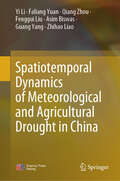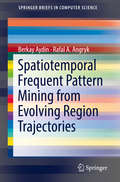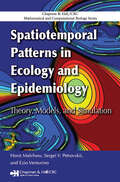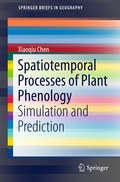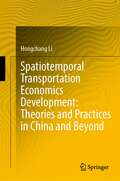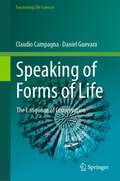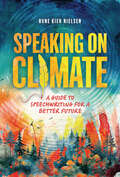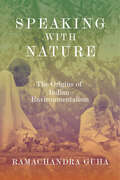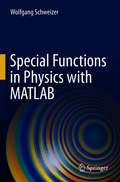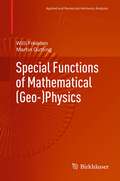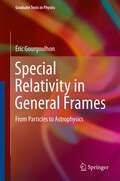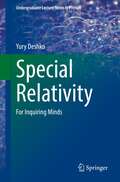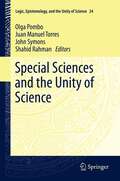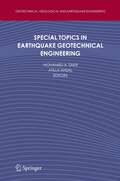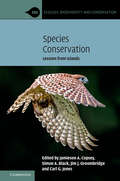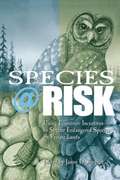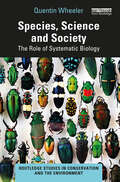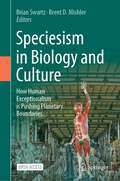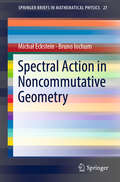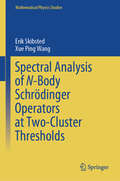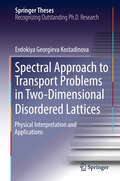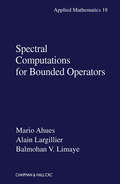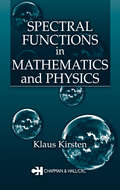- Table View
- List View
Spatiotemporal Dynamics of Meteorological and Agricultural Drought in China
by Yi Li Guang Yang Asim Biswas Faliang Yuan Qiang Zhou Fenggui Liu Zhihao LiaoThis book explores spatiotemporal analysis and impact assessment of agricultural drought in China and investigates the correlation coefficient between meteorological drought and agricultural drought. It then conducts multivariate frequency analysis of drought events using drought indices and copula functions. It aims to reveal spatiotemporal characteristics and impacts of agricultural drought in China both on vegetation phenology and productivity. The book assesses the performances of drought indices for better predicting multi-year droughts and return periods and drought risk assessment.
Spatiotemporal Frequent Pattern Mining from Evolving Region Trajectories (SpringerBriefs in Computer Science)
by Berkay Aydin Rafal. A AngrykThis SpringerBrief provides an overview within data mining of spatiotemporal frequent pattern mining from evolving regions to the perspective of relationship modeling among the spatiotemporal objects, frequent pattern mining algorithms, and data access methodologies for mining algorithms. While the focus of this book is to provide readers insight into the mining algorithms from evolving regions, the authors also discuss data management for spatiotemporal trajectories, which has become increasingly important with the increasing volume of trajectories.This brief describes state-of-the-art knowledge discovery techniques to computer science graduate students who are interested in spatiotemporal data mining, as well as researchers/professionals, who deal with advanced spatiotemporal data analysis in their fields. These fields include GIS-experts, meteorologists, epidemiologists, neurologists, and solar physicists.
Spatiotemporal Patterns in Ecology and Epidemiology: Theory, Models, and Simulation (Chapman & Hall/CRC Mathematical Biology Series)
by Horst Malchow Sergei V. Petrovskii Ezio VenturinoAlthough the spatial dimension of ecosystem dynamics is now widely recognized, the specific mechanisms behind species patterning in space are still poorly understood and the corresponding theoretical framework is underdeveloped. Going beyond the classical Turing scenario of pattern formation, Spatiotemporal Patterns in Ecology and Epidemiology:
Spatiotemporal Processes of Plant Phenology
by Xiaoqiu ChenThisbook deals with phenology, the study of recurring biological life cycle stages,and especially their timing and relationships with biotic and abiotic forces. Given the theoretical and methodologicalinnovations involved, the chapters on defining spatiotemporal patterns of plantphenology and constructing daily temperature-based temporal/spatial models andprocess-based regional unified models will be of particular interest. Helping readers discover and explore plant phenology'sperspectives in terms of spatiotemporal patterns, processes and mechanisms, thebook will also equip young scientists and graduate students to understand thecauses of spatiotemporal variation in vegetation seasonality.
Spatiotemporal Processes of Plant Phenology: Simulation and Prediction (SpringerBriefs in Geography)
by Xiaoqiu ChenThis book deals with phenology, the study of recurring biological life cycle stages, and especially their timing and relationships with biotic and abiotic forces. Given the theoretical and methodological innovations involved, the chapters on defining spatiotemporal patterns of plant phenology and constructing daily temperature-based temporal/spatial models and process-based regional unified models will be of particular interest. Helping readers discover and explore plant phenology’s perspectives in terms of spatiotemporal patterns, processes and mechanisms, the book will also equip young scientists and graduate students to understand the causes of spatiotemporal variation in vegetation seasonality.
Spatiotemporal Transportation Economics Development: Theories and Practices in China and Beyond
by Hongchang LiThis book focuses on the analysis of transportation economics development with spatiotemporal characteristics in both theory and practice. The comprehensive and general theory development, practical transportation events and policy implications are addressed. The book pursues three main objectives: firstly, to structurally describe the overall spatiotemporal transportation theory development; secondly, to break down transportation elements and transportation modes into railway, highway, water, civil aviation, pipeline and urban transportation for the purposes of in-depth professional analysis; and thirdly, to summarize transportation trends including car-hailing, shared bicycles, etc., in China to reveal their policy implications.
Speaking of Forms of Life: The Language of Conservation (Fascinating Life Sciences)
by Daniel Guevara Claudio CampagnaHumans pose an unprecedented threat to life in all its great diversity of forms. The human-induced extinction rate has been compared to “mass extinctions” of the past. But this language masks the fact that the crisis is due to voluntary, and thus, avoidable choices and actions. “Speaking of Forms of Life” shows that at the root of this crisis is the tragic inadequacy of the language predominantly used to represent and address what we are doing, including the language of “sustainable development,” “rights” for animals and the rest of nature, their “intrinsic value,” and conservation of species as “populations.” This talk alienates us from the other living things, from what they actually are, have and do, and it perpetuates the harm and loss. Campagna and Guevara compellingly argue, on rigorous but accessible grounds, that there is an alternative language to guide conservation, in confronting the radically urgent, ethical issues it faces. This is a language with which we are all familiar, mastered by naturalists, from Aristotle to Audubon. It articulates the primary value in life and the standard that must guide how human beings should live, as one form of life, among countless others. This book is a homecoming for those who practice conservation to, above all else, secure a creature’s ability to satisfy the necessities of its form of life.
Speaking on Climate: A Guide to Speechwriting for a Better Future
by Rune Kier NielsenA Junior Library Guild Gold Standard Selection What makes a good speech? Better yet, what makes an effective speech? A speech can inform, entertain, educate. But effective speeches inspire an audience to act and build a sense of community. The climate crisis is a pressing issue, and the ability to successfully communicate about it is crucial to bring people together to make meaningful change. Discover how to stand up, speak your mind, and encourage your audience past climate silence. By analyzing speeches and how they worked, social anthropologist and professional speechwriter Rune Kier Nielsen breaks down nine common flaws of climate rhetoric and how to fix them in this thorough, engaging guide to speechwriting toward climate action. "A lively, concise, and practical antidote to climate anxiety and a guide to positive action."—Kirkus Reviews "Speaking on Climate by Rune Kier Nielsen is a crucial guide for anyone committed to using the power of words to drive meaningful climate action."—Ingmar Rentzhog, founder & CEO, Wedonthavetime.org "Rune Kier Nielsen's Speaking on Climate inspires readers' passion for climate change and equips them with the tools to communicate effectively."—S. Kelley Harrell, author of From Elder to Ancestor: Nature Kinship for All Seasons of Life
Speaking with Nature: The Origins of Indian Environmentalism
by Ramachandra GuhaFrom one of the world&’s leading historians comes the first substantial study of environmentalism set in any country outside the Euro-American world By the canons of orthodox social science, countries like India are not supposed to have an environmental consciousness. They are, as it were, &“too poor to be green.&” In this deeply researched book, Ramachandra Guha challenges this narrative by revealing a virtually unknown prehistory of the global movement set far outside Europe or America. Long before the publication of Rachel Carson&’s Silent Spring and well before climate change, ten remarkable individuals wrote with deep insight about the dangers of environmental abuse from within an Indian context. In strikingly contemporary language, Rabindranath Tagore, Radhakamal Mukerjee, J. C. Kumarappa, Patrick Geddes, Albert and Gabrielle Howard, Mira, Verrier Elwin, K. M. Munshi, and M. Krishnan wrote about the forest and the wild, soil and water, urbanization and industrialization. Positing the idea of what Guha calls &“livelihood environmentalism&” in contrast to the &“full-stomach environmentalism&” of the affluent world, these writers, activists, and scientists played a pioneering role in shaping global conversations about humanity&’s relationship with nature. Spanning more than a century of Indian history, and decidedly transnational in reference, this book offers rich resources for considering the threat of climate change today.
Special Functions in Physics with MATLAB
by Wolfgang SchweizerThis handbook focuses on special functions in physics in the real and complex domain. It covers more than 170 different functions with additional numerical hints for efficient computation, which are useful to anyone who needs to program with other programming languages as well. The book comes with MATLAB-based programs for each of these functions and a detailed html-based documentation. Some of the explained functions are: Gamma and Beta functions; Legendre functions, which are linked to quantum mechanics and electrodynamics; Bessel functions; hypergeometric functions, which play an important role in mathematical physics; orthogonal polynomials, which are largely used in computational physics; and Riemann zeta functions, which play an important role, e.g., in quantum chaos or string theory. The book’s primary audience are scientists, professionals working in research areas of industries, and advanced students in physics, applied mathematics, and engineering.
Special Functions of Mathematical (Applied and Numerical Harmonic Analysis)
by Willi Freeden Martin GuttingSpecial functions enable us to formulate a scientific problem by reduction such that a new, more concrete problem can be attacked within a well-structured framework, usually in the context of differential equations. A good understanding of special functions provides the capacity to recognize the causality between the abstractness of the mathematical concept and both the impact on and cross-sectional importance to the scientific reality. The special functions to be discussed in this monograph vary greatly, depending on the measurement parameters examined (gravitation, electric and magnetic fields, deformation, climate observables, fluid flow, etc.) and on the respective field characteristic (potential field, diffusion field, wave field). The differential equation under consideration determines the type of special functions that are needed in the desired reduction process. Each chapter closes with exercises that reflect significant topics, mostly in computational applications. As a result, readers are not only directly confronted with the specific contents of each chapter, but also with additional knowledge on mathematical fields of research, where special functions are essential to application. All in all, the book is an equally valuable resource for education in geomathematics and the study of applied and harmonic analysis. Students who wish to continue with further studies should consult the literature given as supplements for each topic covered in the exercises.
Special Relativity in General Frames: From Particles to Astrophysics
by Éric GourgoulhonSpecial relativity is the basis of many fields in modern physics: particle physics, quantum field theory, high-energy astrophysics, etc. This theory is presented here by adopting a four-dimensional point of view from the start. An outstanding feature of the book is that it doesn't restrict itself to inertial frames and to considering accelerated and rotating observers. It is thus possible to treat physical effects such as the Thomas precession or the Sagnac effect in a simple yet precise manner. In the final chapters, more advanced topics like tensorial fields in spacetime, exterior calculus and relativistic hydrodynamics are addressed. In the last, brief chapter the author gives a preview of gravity and shows where it becomes incompatible with Minkowsky spacetime. Well illustrated and enriched by many historical notes, this book also presents many applications of special relativity, ranging from particle physics (accelerators, particle collisions, quark-gluon plasma) to astrophysics (relativistic jets, active galactic nuclei), and including practical applications (Sagnac gyrometers, synchrotron radiation, GPS). In addition, the book provides some mathematical developments, such as the detailed analysis of the Lorentz group and its Lie algebra. The book is suitable for students in the third year of a physics degree or on a masters course, as well as researchers and any reader interested in relativity. Thanks to the geometric approach adopted, this book should also be beneficial for the study of general relativity. "A modern presentation of special relativity must put forward its essential structures, before illustrating them using concrete applications to specific dynamical problems. Such is the challenge (so successfully met!) of the beautiful book by Éric Gourgoulhon." (excerpt from the Foreword by Thibault Damour)
Special Relativity: For Inquiring Minds (Undergraduate Lecture Notes in Physics)
by Yury DeshkoThis textbook introduces the special theory of relativity at a level which is accessible to undergraduate students and even high school students with a strong foundation in algebra. The presentation emphasizes clean algebraic and geometrical methods, visualized with plenty of illustrations, resulting in a textbook that is modern and serious yet accessible. Replete with many solved exercises and copious spacetime diagrams, this book will help students develop relativistic intuition when encountering the subject for the first time. The emphasis on geometric methods, combined with the pedagogically appealing k-calculus approach, makes this book ideal for a self-contained course on special relativity or as supplementary reading for modern physics courses. It will also appeal to high schoolers with a strong math background who want to get ahead.
Special Sciences and the Unity of Science
by Shahid Rahman Olga Pombo John Symons Juan Manuel TorresScience is a dynamic process in which the assimilation of new phenomena, perspectives, and hypotheses into the scientific corpus takes place slowly. The apparent disunity of the sciences is the unavoidable consequence of this gradual integration process. Some thinkers label this dynamical circumstance a 'crisis'. However, a retrospective view of the practical results of the scientific enterprise and of science itself, grants us a clear view of the unity of the human knowledge seeking enterprise. This book provides many arguments, case studies and examples in favor of the unity of science. These contributions touch upon various scientific perspectives and disciplines such as: Physics, Computer Science, Biology, Neuroscience, Cognitive Psychology, and Economics.
Special Topics in Earthquake Geotechnical Engineering
by Atilla Ansal Mohamed A. SakrGeotechnical Earthquake Engineering and Soil Dynamics, as well as their interface with Engineering Seismology, Geophysics and Seismology, have all made remarkable progress over the past 15 years, mainly due to the development of instrumented large scale experimental facilities, to the increase in the quantity and quality of recorded earthquake data, to the numerous well-documented case studies from recent strong earthquakes as well as enhanced computer capabilities. One of the major factors contributing to the aforementioned progress is the increasing social need for a safe urban environment, large infrastructures and essential facilities. The main scope of our book is to provide the geotechnical engineers, geologists and seismologists, with the most recent advances and developments in the area of earthquake geotechnical engineering, seismology and soil dynamics.
Species Conservation: Lessons from Islands (Ecology, Biodiversity and Conservation)
by Jamieson A. Copsey Simon A. Black Jim J. Groombridge Carl G. JonesThis book brings together leading conservation practitioners to reflect on their response to the current global biodiversity crisis, through the lens of island species recovery and management. Initial chapters cover the biological understanding of small population biology and the growing threat of invasive species, while subsequent chapters discuss the management of these threats and the complexity of leading projects within a dynamic and still relatively unknown system. Multiple case studies from islands worldwide illustrate key points, allowing readers to draw on the first-hand practical experience of experienced professionals. This resource will be invaluable to both current and future conservation professionals, helping them to go beyond disciplinary 'comfort zones' and develop, manage and lead projects over extensive timeframes in a way that brings others with them on the journey.
Species at Risk: Using Economic Incentives to Shelter Endangered Species on Private Lands
by Jason F. ShogrenProtecting endangered species of animals and plants is a goal that almost everyone supports in principle--but in practice private landowners have often opposed the regulations of the Endangered Species Act, which, they argue, unfairly limits their right to profit from their property. <P><P>To encourage private landowners to cooperate voluntarily in species conservation and to mitigate the economic burden of doing so, the government and nonprofit land trusts have created a number of incentive programs, including conservation easements, leases, habitat banking, habitat conservation planning, safe harbors, candidate conservation agreements, and the "no surprise" policy.
Species, Science and Society: The Role of Systematic Biology (Routledge Studies in Conservation and the Environment)
by Quentin WheelerThis book presents an engaging and accessible examination of the role of systematic biology in species exploration and biodiversity conservation. Our planet and systematic biology are at a crossroads. Millions of species face an imminent threat of extinction, and, with knowledge of only a fraction of earth’s species we are unprepared to respond. Species, Science and Society explains what is at stake if we continue to ignore the traditional mission of systematics. Rejecting claims that it is too late to document earth’s species, that molecular evidence is sufficient and that comparative morphology and the grand traditions of systematics are outdated, this book makes a compelling argument for a taxonomic renaissance. The book challenges readers to rethink assumptions about systematics. Shattering myths and misconceptions and clarifying the role of systematics in confronting mass extinction, it hopes to inspire a new generation of systematists. Readers are given a deeply personal view of the mission, motivations and rewards of systematic biology. Written in narrative style with passion, wit and optimism, it is the first book to question the growing dominance of molecular data, defend descriptive taxonomy and propose a mission to discover, describe and classify all species. Our evolutionary heritage, the fate of society and the future of the planet depend on what we do next. This book will be of great interest to academics, researchers and professionals working in systematics, taxonomy and biodiversity conservation, as well as students with a basic background in biology.
Species, Science and Society: The Role of Systematic Biology (Routledge Studies in Conservation and the Environment)
by Quentin Wheeler- presents an engaging and accessible examination of the role of systematic biology in species exploration and biodiversity conservation - clarifies misconceptions about systematic biology, reimagining it for the 21st Century - proposes an ambitious, planetary-scale project to inventory and make known every kind of plant, animal, and microbe on Earth - challenges the next and present generations of taxonomists to allow molecular data to assume it’s proper place alongside traditional data, to reembrace the fundamentally important mission of systematics - will be of great interest to those researching and working in systematics in botany and zoology, as well as professionals working in taxonomy and biodiversity conservation.
Speciesism in Biology and Culture: How Human Exceptionalism is Pushing Planetary Boundaries
by Brent D. Mishler Brian SwartzThis open access book explores a wide-ranging discussion about the sociopolitical, cultural, and scientific ramifications of speciesism and world views that derive from it. In this light, it integrates subjects across the natural sciences, social sciences, and humanities. The 21st-century western world is anthropocentric to an extreme; we adopt unreasonably self-centered and self-serving ideas and lifestyles. Americans consume more energy resources per person than most other nations on Earth and have little concept of how human ecology and population biology interface with global sustainability. We draw upon religion, popular culture, politics, and technology to justify our views and actions, yet remain self-centered because our considerations rarely extend beyond our immediate interests. Stepping upward on the hierarchy from “racism,” “speciesism” likewise refers to the view that unique natural kinds (species) exist and are an important structural element of biodiversity. This ideology manifests in the cultural idea that humans are distinct from and intrinsically superior to other forms of life. It further carries a plurality of implications for how we perceive ourselves in relation to nature, how we view Judeo-Christian religions and their tenets, how we respond to scientific data about social problems such as climate change, and how willing we are to change our actions in the face of evidence.
Spectral Action in Noncommutative Geometry (SpringerBriefs in Mathematical Physics #27)
by Michał Eckstein Bruno IochumWhat is spectral action, how to compute it and what are the known examples? This book offers a guided tour through the mathematical habitat of noncommutative geometry à la Connes, deliberately unveiling the answers to these questions.After a brief preface flashing the panorama of the spectral approach, a concise primer on spectral triples is given. Chapter 2 is designed to serve as a toolkit for computations. The third chapter offers an in-depth view into the subtle links between the asymptotic expansions of traces of heat operators and meromorphic extensions of the associated spectral zeta functions. Chapter 4 studies the behaviour of the spectral action under fluctuations by gauge potentials. A subjective list of open problems in the field is spelled out in the fifth Chapter. The book concludes with an appendix including some auxiliary tools from geometry and analysis, along with examples of spectral geometries.The book serves both as a compendium for researchers in the domain of noncommutative geometry and an invitation to mathematical physicists looking for new concepts.
Spectral Analysis of N-Body Schrödinger Operators at Two-Cluster Thresholds (Mathematical Physics Studies)
by Erik Skibsted Xue Ping WangThis book provides a systematic study of spectral and scattering theory for many-body Schrödinger operators at two-cluster thresholds. While the two-body problem (reduced after separation of the centre of mass motion to a one-body problem at zero energy) is a well-studied subject, the literature on many-body threshold problems is sparse. However, the authors’ analysis covers for example the system of three particles interacting by Coulomb potentials and restricted to a small energy region to the right of a fixed nonzero two-body eigenvalue. In general, the authors address the question: How do scattering quantities for the many-body atomic and molecular models behave within the limit when the total energy approaches a fixed two-cluster threshold? This includes mapping properties and singularities of the limiting scattering matrix, asymptotics of the total scattering cross section, and absence of transmission from one channel to another in the small inter-cluster kinetic energy region. The authors’ principal tools are the Feshbach–Grushin dimension reduction method and spectral analysis based on a certain Mourre estimate. Additional topics of independent interest are the limiting absorption principle, micro-local resolvent estimates, Rellich- and Sommerfeld-type theorems and asymptotics of the limiting resolvents at thresholds. The mathematical physics field under study is very rich, and there are many open problems, several of them stated explicitly in the book for the interested reader.
Spectral Approach to Transport Problems in Two-Dimensional Disordered Lattices: Physical Interpretation And Applications (Springer Theses)
by Evdokiya Georgieva KostadinovaThis book introduces the spectral approach to transport problems in infinite disordered systems characterized by Anderson-type Hamiltonians. The spectral approach determines (with probability one) the existence of extended states for nonzero disorder in infinite lattices of any dimension and geometry. Here, the author focuses on the critical 2D case, where previous numerical and experimental results have shown disagreement with theory. Not being based on scaling theory, the proposed method avoids issues related to boundary conditions and provides an alternative approach to transport problems where interaction with various types of disorder is considered.Beginning with a general overview of Anderson-type transport problems and their relevance to physical systems, it goes on to discuss in more detail the most relevant theoretical, numerical, and experimental developments in this field of research. The mathematical formulation of the innovative spectral approach is introduced together with a physical interpretation and discussion of its applicability to physical systems, followed by a numerical study of delocalization in the 2D disordered honeycomb, triangular, and square lattices. Transport in the 2D honeycomb lattice with substitutional disorder is investigated employing a spectral analysis of the quantum percolation problem. Next, the applicability of the method is extended to the classical regime, with an examination of diffusion of lattice waves in 2D disordered complex plasma crystals, along with discussion of proposed future developments in the study of complex transport problems using spectral theory.
Spectral Computations for Bounded Operators
by Mario Ahues Alain Largillier Balmohan LimayeExact eigenvalues, eigenvectors, and principal vectors of operators with infinite dimensional ranges can rarely be found. Therefore, one must approximate such operators by finite rank operators, then solve the original eigenvalue problem approximately. Serving as both an outstanding text for graduate students and as a source of current results for
Spectral Functions in Mathematics and Physics
by Klaus KirstenThe literature on the spectral analysis of second order elliptic differential operators contains a great deal of information on the spectral functions for explicitly known spectra. The same is not true, however, for situations where the spectra are not explicitly known. Over the last several years, the author and his colleagues have developed new,
